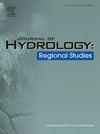Attributing the effects of climate change and forest disturbance on runoff using distributed modeling and indicators of hydrological alteration in Central European montane basins
IF 4.7
2区 地球科学
Q1 WATER RESOURCES
引用次数: 0
Abstract
Study region
Eight unregulated basins in the headwaters of five mid-latitude mountain ranges in Central Europe, including the Šumava Mts. (Vydra, Blanice), Krkonoše (Mumlava, Úpa), Orlické Mts. (Zdobnice), Jeseníky Mts. (Branná), and Beskydy Mts. (Čeladenka, Vsetínská Bečva).
Study focus
This study examines the impacts of climate warming and forest disturbances on hydrological alterations in montane headwater basins. Using the MIKE SHE distributed hydrological model, scenario-based simulations assessed changes in runoff seasonality, evapotranspiration, streamflow, and variability. Hydrological alteration indicators were applied to disentangle the contributions of these drivers and their interactions under varying environmental conditions.
New hydrological insights for the region
Climate warming is the primary driver of hydrological change, causing shifts in runoff seasonality, increased evapotranspiration, and reduced streamflow. Forest disturbances amplify these effects during dry conditions, intensifying runoff variability, increasing low-flow frequency, and modifying peak flows. Regional differences show greater sensitivity in steeper eastern basins due to limited snow accumulation and higher runoff variability. This study highlights the interconnected impacts of climate warming and forest disturbances, with warming driving systemic shifts and disturbances acting as amplifiers in extreme conditions. The findings provide a framework for disentangling the effects of climate and land-cover changes on hydrology, offering insights for managing sensitive montane ecosystems and water resources under changing environmental conditions.
求助全文
约1分钟内获得全文
求助全文
来源期刊

Journal of Hydrology-Regional Studies
Earth and Planetary Sciences-Earth and Planetary Sciences (miscellaneous)
CiteScore
6.70
自引率
8.50%
发文量
284
审稿时长
60 days
期刊介绍:
Journal of Hydrology: Regional Studies publishes original research papers enhancing the science of hydrology and aiming at region-specific problems, past and future conditions, analysis, review and solutions. The journal particularly welcomes research papers that deliver new insights into region-specific hydrological processes and responses to changing conditions, as well as contributions that incorporate interdisciplinarity and translational science.
 求助内容:
求助内容: 应助结果提醒方式:
应助结果提醒方式:


